<< Previous | Displaying results 1-25 of 2604 for "" | Next >>
-
Close-up of corpses in the crematorium mortuary in Dachau
PhotoClose-up of corpses piled in the crematorium mortuary in the newly liberated Dachau concentration camp. Dachau, Germany, May 1945. This image is among the commonly reproduced and distributed, and often extremely graphic, images of liberation. These photographs provided powerful documentation of the crimes of the Nazi era.
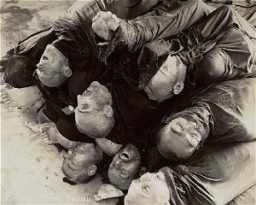
-
Bodies of victims in the Nordhausen camp
PhotoView of the main street of the Nordhausen concentration camp, outside of the central barracks (Boelke Kaserne), where the bodies of prisoners have been laid out in long rows. Nordhausen, Germany, April 13–14, 1945. This image is among the commonly reproduced and distributed, and often extremely graphic, images of liberation. These photographs provided powerful documentation of the crimes of the Nazi era.
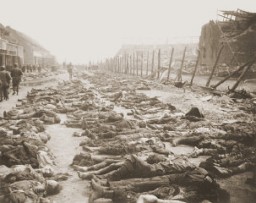
-
German civilians are forced to view a wagon piled with corpses
PhotoGerman civilians under US military escort are forced to view a wagon piled with corpses in the newly liberated Buchenwald concentration camp. Buchenwald, Germany, April 16, 1945.
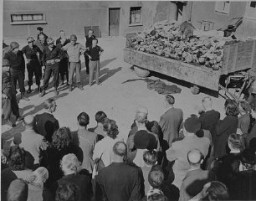
-
Victims of the Buchenwald concentration camp
PhotoA wagon is piled with the bodies of victims of the Buchenwald concentration camp. Photograph taken following the liberation of the camp. The 6th Armored Division overran the camp on April 11, 1945. Buchenwald, Germany, April 11–May 1945.
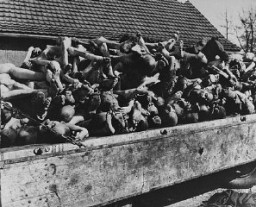
-
Former prisoners of the "little camp" in Buchenwald
PhotoFormer prisoners of the "little camp" in Buchenwald stare out from the wooden bunks in which they slept three to a "bed." Elie Wiesel is pictured in the second row of bunks, seventh from the left, next to the vertical beam. Abraham Hipler is pictured in the second row, fourth from the left. The man on the third bunk from the bottom, third from the left, is Ignacz (Isaac) Berkovicz. [He has also been identified as Abraham Baruch.] Michael Nikolas Gruner, originally from Hungary, is pictured on the bottom…
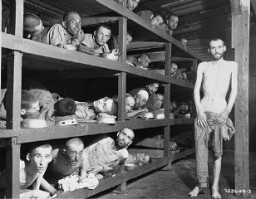
-
Bodies of victims outside the crematorium in Buchenwald
PhotoThe bodies of former prisoners are stacked outside the crematorium in the newly liberated Buchenwald concentration camp. Buchenwald, Germany, April 23, 1945. This image is among the commonly reproduced and distributed, and often extremely graphic, images of liberation. These photographs provided powerful documentation of the crimes of the Nazi era.

-
Victims of the Buchenwald camp
PhotoA wagon is piled high with the bodies of victims of the Buchenwald concentration camp. Photograph taken following the liberation of the camp. Buchenwald, Germany, April 16, 1945.
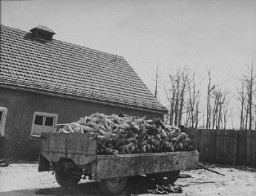
-
The charred corpse of a prisoner killed near Gardelegen
PhotoThe charred corpse of a prisoner killed by the SS in a barn just outside of Gardelegen. The SS guards locked the prisoners, who were on a death march from the Dora-Mittelbau camp, in a barn, which was then set ablaze. Gardelegen, Germany, April 16, 1945. This image is among the commonly reproduced and distributed, and often extremely graphic, images of liberation. These photographs provided powerful documentation of the crimes of the Nazi era.
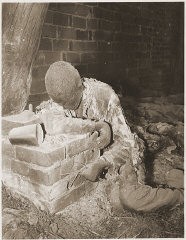
-
The charred remains of former prisoners in two crematoria ovens in the newly liberated Buchenwald concentration camp.
PhotoThe charred remains of former prisoners in two crematoria ovens in the newly liberated Buchenwald concentration camp. Buchenwald, Germany, April 14, 1945. This image is among the commonly reproduced and distributed, and often extremely graphic, images of liberation. These photographs provided powerful documentation of the crimes of the Nazi era.
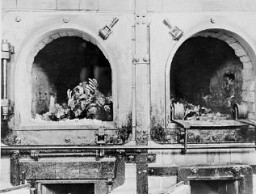
-
Two ovens inside the Dachau crematorium
PhotoTwo ovens inside the crematorium at the Dachau concentration camp. Dachau, Germany, July 1, 1945. This image is among the commonly reproduced and distributed images of liberation. These photographs provided powerful documentation of the crimes of the Nazi era.
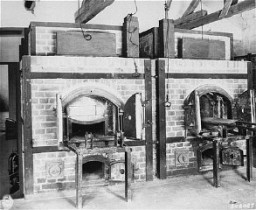
-
Corpses in Dachau
PhotoA pile of corpses in the newly liberated Dachau concentration camp. Dachau, Germany, April 29-May 1945. This image is among the commonly reproduced and distributed, and often extremely graphic, images of liberation. These photographs provided powerful documentation of the crimes of the Nazi era.
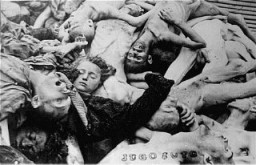
-
Bodies outside the crematorium at Dachau
PhotoThe bodies of former prisoners are piled outside the crematorium at the newly liberated Dachau concentration camp. Dachau, Germany, April–May 1945. This image is among the commonly reproduced and distributed, and often extremely graphic, images of liberation. These photographs provided powerful documentation of the crimes of the Nazi era.

-
Beifeld album cover
PhotoCover to György Beifeld's album, featuring a road sign with the Hungarian Labor Service company number 109/13 posted in a muddy wasteland. The Jewish labor servicemen were forced to construct roads on these muddy fields to accommodate the advance of the Hungarian 2nd Army toward the Don River.
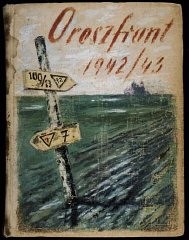
-
Beifeld album page
PhotoIn a take-off of travel posters advertising peaceful vacation spots, Beifeld draws a picture of a Hungarian military tent pitched next to a tree on which a bird is cheerfully chirping. Next to the tent the artist writes "Peaceful Surroundings" but above, a Soviet bomber releases a bomb aimed at the tent. [Photograph #58022]

-
Doll belonging to Inge Auerbacher
PhotoIn 1942, seven-year-old Inge Auerbacher was deported with her parents to the Theresienstadt ghetto. She brought along this doll, named “Marlene” after German actress Marlene Dietrich, which her grandmother had given her. It would remain with Inge throughout her three years of imprisonment in the ghetto.
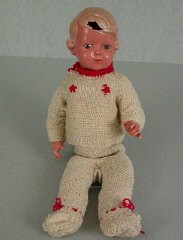
-
Frieda Greinegger and Julian Noga
PhotoA hand-tinted photograph of Frieda Greinegger and Julian Noga as a young couple. The two had met when Julian, a forced laborer from Poland, arrived at the Greinegger farm in northern Austria. In 1941, the Gestapo sent both to concentration camps after learning of their forbidden friendship. Place uncertain, after 1945.
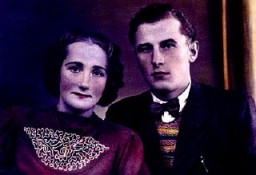
-
A family outing in happier times
PhotoFrieda Greinegger during a family outing to a park in the mid-1930s. Frieda would later spend almost two years in the Ravensbrück concentration camp as punishment for consorting with a Polish forced laborer, Julian Noga. Austria, ca. 1935.
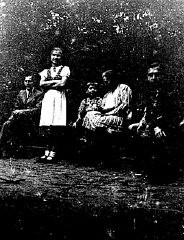
-
A portrait of the Greinegger family
PhotoThe Greinegger family, shown here in a formal portrait, were prosperous farmers in northern Austria. During World War II, the son died as a soldier in the German army. The second youngest daughter, Frieda, spent almost two years in Ravensbrück concentration camp for consorting with a Polish forced laborer, Julian Noga. Frieda and Julian married after the war. Place and date of photograph uncertain.
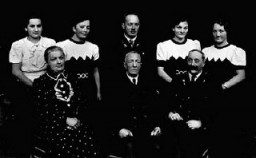
-
Two French partisans
PhotoTwo French partisans, Missak Manouchian (left) and Wolf Wajsbrot (right), who belonged to the French armed resistance group Francs-Tireurs et Partisans. They were executed by firing squad on February 21, 1944. Paris, France, February, 1944.

-
Fritz and Ida Lang, Jewish proprietors of a dry goods store in Germany
PhotoFritz and Ida Lang, Jewish proprietors of a dry goods store in Lambsheim, posed for this picture around 1934. In the early 1940s, Nazi authorities deported the Langs and their young daughter, Freya, to detention camps in France. Ida died after deportation to Auschwitz. Fritz survived and reunited with his daughter in 1946. Lambsheim, Germany, ca. 1934.
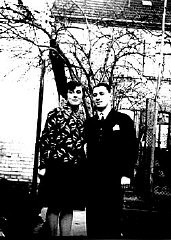
-
Mother and infant daughter in Germany
PhotoIda Baehr Lang holding her infant daughter, Freya Karoline, in Lambsheim. Ida died in the mid-1940s after deportation to Auschwitz. Freya survived in hiding in France and reunited with her father in 1946. Lambsheim, Germany, ca. 1934.

-
Dutch Seventh-day Adventist Johan Weidner
PhotoDutch Seventh-day Adventist Johan Weidner headed the rescue organization "Dutch-Paris," which smuggled Jewish refugees into Switzerland and Spain. France, ca. 1940.
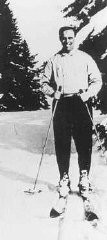
-
Escaping though the Pyrenees
PhotoJewish refugees from France and the Netherlands make their way from France into Spain through a pass in the Pyrenees mountain range. They are being rescued by "Dutch-Paris," an organization created by Seventh-day Adventist Johan Weidner. Ca. 1940.
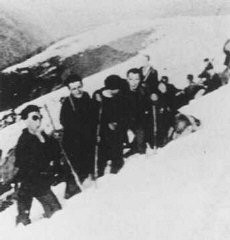
-
Portrait of the Rosenblat family in interwar Poland
PhotoPortrait of the Rosenblat family in interwar Poland. Photographed are: (back row from left to right) Elya, Jozef (father), and Itzik Rosenblat. Sitting from left to right are: Herschel, Deena (wife of Elya), Hannah (mother), and Taube Rosenblat (wife of Itzik). In 1941, a mobile killing unit killed Herschel in Slonim, Poland. Of the others, only Itzik and Deena survived deportation from the ghetto in Radom, Poland.
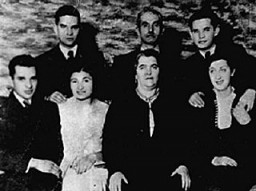
-
Portrait of David Aruti, son of Isak Aruti
PhotoPortrait of David Aruti, son of Isak Aruti. He was a merchant and lived at Zvornitska 26 in Bitola. This photograph was one of the individual and family portraits of members of the Jewish community of Bitola, Macedonia, used by Bulgarian occupation authorities to register the Jewish population prior to its deportation in March 1943.

